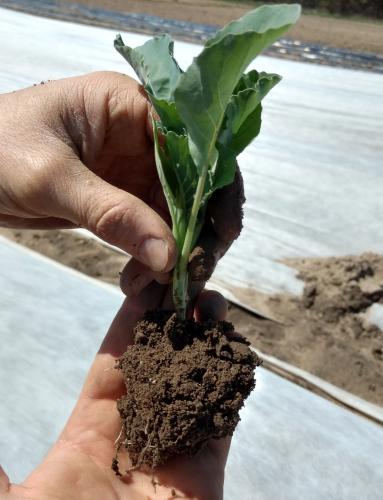East Michigan vegetable update – April 26, 2017
Planting of cool-season crops is underway and transplants of all types are slated for May sales and field planting.
Weather
It’s been wet enough to delay some plantings in Imlay City, Michigan, muck soils, and also in the clayier soils around the Bay. We’ve had about five consecutive days without rain, but more is predicted with a large system forecasted for the weekend.
The table below shows degree-day (base 50 degrees Fahrenheit since March 1) and rainfall (inches since April 1) accumulations to date, and soil temperature ranges (top 2 inches) over the last seven days from Michigan State University Enviro-weather stations in the region.
| Rainfall and degree-day (DD) totals as of April 26, 2017 | |||||
|---|---|---|---|---|---|
| Location | DD | DD 5-year average | Rainfall | Rainfall 5-year average | Soil temperature range |
| Emmett | 110 | 89.9 | 2.77 | 1.51 | 49 – 63 |
| Fairgrove | 122 | 95.6 | 3.61 | 2.31 | 43 – 55 |
| Flint | 159 | 87.4 | 4.24 | 2.94 | 29 – 83 |
| Frankenmuth | 132 | 105.6 | 4.89 | 2.82 | 43 – 57 |
| Freeland | 121 | 86.5 | 5.36 | 3.08 | 43 – 53 |
| Lapeer | 148 | 113.1 | 2.51 | 2.66 | 45 – 66 |
| Linwood | 101 | 72 | 5.33 | 3.37 | 44 – 56 |
| Munger | 117 | 83.9 | 4.82 | 2.67 | 45 – 58 |
| Romeo | 131 | 112.4 | 2.38 | 1.99 | 42 – 67 |
| Sandusky | 100 | 78.7 | 3.47 | 2.5 | 40 – 59 |
Crops
Seeded onions were planted around April 11 in Imlay City, and are all in where conditions allowed.
Transplanted sweet onions have been placed out with plastic mulches last week.
The first sets of transplanted lettuce started going in around April 13 in Imlay City and has been continuing as conditions allow. Hoophouse lettuce and Asian greens growers have reported issues with bolting this spring with the wildly fluctuating air temperatures.
Seeded carrots should be starting soon, if not already, as conditions allow. A light rain following seeding can soften soil and help with emergence, but a hard rain can cause soil crusting that disrupts emergence.
The first sets of transplanted cole crops have been set out in plastic beds for one week, some with low tunnel covers. The conditions are good for bareground transplants to go out, too. Sulfur butterflies have already been seen.

Cabbage roots wiggled free of the cell tray medium and into the surrounding field soil within seven days in these Cass City transplants. Off to a good start.
Garlic is 6-8 inches tall, some showing nutrient deficiencies. Mulch has been off for a month or so.
Asparagus has begun emerging, indicated about three weeks before major harvest time. I visited a field of Jersey in Cass City with two to four spears per plant and the longest spear about 10 inches. For herbicide applications at this point, mow off the spears before application, and be very aware of pre-harvest intervals (PHI).
Metribuzin (14-day PHI) at 0.63-1.3 pounds per acre and diuron (applied up to first harvest) at 1-4 pounds per acre are standards for un-emerged weeds. Glyphosate has a five-day PHI if applied before asparagus is up, or as spot treatment of emerged perennial weeds after asparagus comes up. Add clopyralid (two-day PHI) at 8-10.7 fluid ounces per acre if thistles are an issue. However, it will cause some crooked spears.
Strawberry flower trusses are emerging.
Heated hoophouse tomatoes are still green and between 0.5 and 3.5 inches in diameter. Plants are on their fourth flower cluster. I’ve grabbed samples for root-related wilting symptoms showing in a long-term tomato hoophouse already.
Hop sprouts are growing rapidly, up to 6-8 inches a day. Systemic downy mildew pressure should be showing up anytime now with the mild rainy weather. See the “2017 Michigan Hop Management Guide” by MSU Extension for more details.
Tablestock potato planting is underway.
Melon, field tomato and pepper transplants have been started in greenhouses since mid-April in anticipation for retail sale and field plantings. Be aware of tomato transplant bacterial issues in the greenhouse. Keep air moving and vented to reduce the amount of time water droplets stay on the leaves. Streptomycin is only labeled for greenhouse use on tomatoes, and is an effective tool for reducing bacterial pressure before field transplanting. You are not allowed to use Streptomycin on field tomatoes, so use it now if it is needed.
Copper is one of the few other tools in the shed for bacterial issues. Choose your copper based on the metallic copper equivalent, the particles size (if the information is available) and formulation. Hydroxides and oxychlorides have more metallic copper than soaps, salts and sulfates. They are also less likely to burn plants. Smaller particle sizes are more soluble and more likely to burn foliage. Some products may require mixing with lime following label instructions.
Please contact me at phill406@msu.edu or 616-901-7513 to grab any suspected disease samples from your farm, or send diseased plant parts to MSU Diagnostic Services.



 Print
Print Email
Email

